Connect With Us
Blog
Diabetes and Severe Foot Problems

Foot problems are the most common reason diabetics are hospitalized. Diabetics might have slow-healing wounds, infections, or other foot issues they may not even be aware of. This could be due to loss of sensation in the feet known as neuropathy, which is from poor blood flow to the lower extremities. Amputation of a limb could be the result if a wound develops, becomes infected, and is beyond salvaging. Diabetics can also get peripheral arterial disease, or PAD, which can lead to leg arteries becoming too clogged to restore blood flow to the feet. If you are a diabetic, practice proper foot care which includes washing, drying, and moisturizing the feet every day and checking them for wounds or infections regularly. Practicing good foot care also includes scheduling visits with a podiatrist who can help you make sure that diabetes is not causing any other foot conditions in the feet. If you or a loved one has diabetes, it is strongly suggested that you consult with a podiatrist.
Diabetic Limb Salvage
Diabetic limb salvage can be an effective way in preventing the need for limb amputation. If you have a foot ulcer and diabetes, consult with Dr. Yeon A. Shim from Roselle Podiatry Group. Our doctor will assess your condition and provide you with quality foot and ankle treatment.
What Is Diabetic Limb Salvage?
Diabetic limb salvage is the attempt of saving a limb, such as the foot, that has an infected ulcer, from amputation. Podiatrists also try to make sure that there is enough function in the foot after the salvage that it is still usable. Those with diabetes experience poor blood circulation, which prevents proper healing of an ulcer. If the ulcer is left uncheck, it could become infected, which could result in the need for amputation.
Diabetes is the number one cause of non-traumatic amputations in the United States. Amputation has been found to lead to higher mortality rates. This translates into higher healthcare costs, and a reduced quality of life and mobility for amputees. Podiatrists have attempted to increase the prevalence of limb salvage in an attempt to solve these issues.
Diagnosis and Treatment
Limb salvage teams have grown in recent years that utilize a number of different treatments to save the infected limb. This includes podiatrists that specialize in wound care, rehabilitation, orthotics, and surgery. Through a combination of these methods, limb salvage has been found to be an effective treatment for infected limbs, and as an alternative to amputation. Podiatrists will first evaluate the potential for limb salvage and determine if the limb can be saved or must be amputated.
If you have any questions, please feel free to contact our office located in Roselle, NJ . We offer the newest diagnostic and treatment technologies for all your foot care needs.
Why Live with Pain and Numbness in Your Feet?
Obesity and Plantar Pressure

Obesity can affect many different aspects of one’s health, including the health of the feet. When an individual gains a significant amount of weight, they essentially place more weight on their feet when standing and engaging in physical activity. If you are an obese individual, then it is possible that you might be putting yourself at a higher risk of experiencing some kind of increased plantar pressure. Plantar pressure is defined as the field of pressure found in between the sole of the foot and a surface during movement. These effects may be even more pronounced for those who are living with diabetes, who are already prone to suffering a number of different foot afflictions. If you find yourself falling into any of these categories, please consult a podiatrist today to schedule an appointment.
Obesity has become very problematic at this point in time and can have extremely negative effects on the feet. If you’re an obese individual and are concerned about your feet, contact Dr. Yeon A. Shim from Roselle Podiatry Group. Our doctor can provide the care you need to keep you pain-free and on your feet.
Obesity and Your Feet
Since your feet are what support your entire weight when standing, any additional weight can result in pain and swelling. Being overweight is one of the main contributors to foot complications.
Problems & Complications
Extra Weight – Even putting on just a few extra pounds could create serious complications for your feet. As your weight increases, your balance and body will shift, creating new stresses on your feet. This uneven weight distribution can cause pain, even while doing the simplest tasks, such as walking.
Diabetes – People who are overweight are at serious risk of developing type-2 diabetes, which has a drastic impact on the health of your feet. As you get older, your diabetes might worsen, which could lead to loss of feeling in your feet, sores, and bruises. You could also become more prone to various infections.
Plantar fasciitis – Pressure and stress that is placed on muscles, joints, and tendons can trigger plantar fasciitis, which is an inflammation of tissue that forms along the bottom of the foot.
If you have any questions please feel free to contact our office located in Roselle, NJ . We offer the newest diagnostic and treatment technologies for all your foot and ankle needs.
Various Treatment Methods For Broken Toes

Most people notice immediately if they have broken a toe. Broken toes typically occur when the toe is stubbed into a piece of furniture or when something heavy is dropped on them. The symptoms are noticeable and often include immediate swelling, bruising, and difficulty in walking. Pain generally accompanies a broken toe, but it may feel better when the toe is elevated. This can also help reduce swelling and discomfort. In severe fractures, the toe may protrude and appear to be displaced, and surgery may be required to move the bone back into place. An effective treatment method for mild breaks is known as buddy taping. This is done by taping the broken toe to the toe next to it for stability which is needed for proper healing. It is also suggested to wear shoes that can accommodate the broken toe as well as protect the toe from being bent or squashed. If you have sustained a toe injury, please contact a podiatrist who can properly diagnose and effectively treat any ailment involving the feet or toes.
A broken toe can be very painful and lead to complications if not properly fixed. If you have any concerns about your feet, contact Dr. Yeon A. Shim from Roselle Podiatry Group. Our doctor will treat your foot and ankle needs.
What to Know About a Broken Toe
Although most people try to avoid foot trauma such as banging, stubbing, or dropping heavy objects on their feet, the unfortunate fact is that it is a common occurrence. Given the fact that toes are positioned in front of the feet, they typically sustain the brunt of such trauma. When trauma occurs to a toe, the result can be a painful break (fracture).
Symptoms of a Broken Toe
- Throbbing pain
- Swelling
- Bruising on the skin and toenail
- The inability to move the toe
- Toe appears crooked or disfigured
- Tingling or numbness in the toe
Generally, it is best to stay off of the injured toe with the affected foot elevated.
Severe toe fractures may be treated with a splint, cast, and in some cases, minor surgery. Due to its position and the pressure it endures with daily activity, future complications can occur if the big toe is not properly treated.
If you have any questions please feel free to contact our office located in Roselle, NJ . We offer the newest diagnostic and treatment technologies for all your foot and ankle needs.
Where Are the Sesamoid Bones?
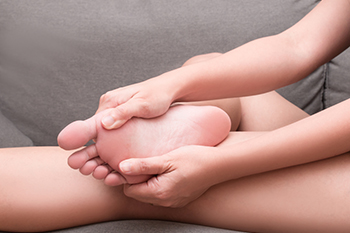
Sesamoiditis is an inflammation of the sesamoid bones. They are located in the ball of the foot and the pain is often found under the joint of the big toe. Their function is to push off while walking or running and can become inflamed if an injury occurs. Treatment often begins with resting and elevating the affected foot. Engaging in low-impact exercises such as swimming or cycling may help to accelerate the healing process. Wearing shoes that have a lower heel may relieve some of the pain as well as taping the big toe. In severe cases, a cast shoe may be recommended to wear as they are made of plastic or wooden soles which can be beneficial in keeping the toes straight while walking. The average recovery time for sesamoiditis may be up to six weeks and normal activities can be resumed when everyday shoes are worn without pain. If you experience any foot pain, it is advised that you consult a podiatrist who can properly diagnose and treat this ailment.
Sesamoiditis is an unpleasant foot condition characterized by pain in the balls of the feet. If you think you’re struggling with sesamoiditis, contact Dr. Yeon A. Shim of Roselle Podiatry Group. Our doctor will treat your condition thoroughly and effectively.
Sesamoiditis
Sesamoiditis is a condition of the foot that affects the ball of the foot. It is more common in younger people than it is in older people. It can also occur with people who have begun a new exercise program, since their bodies are adjusting to the new physical regimen. Pain may also be caused by the inflammation of tendons surrounding the bones. It is important to seek treatment in its early stages because if you ignore the pain, this condition can lead to more serious problems such as severe irritation and bone fractures.
Causes of Sesamoiditis
- Sudden increase in activity
- Increase in physically strenuous movement without a proper warm up or build up
- Foot structure: those who have smaller, bonier feet or those with a high arch may be more susceptible
Treatment for sesamoiditis is non-invasive and simple. Doctors may recommend a strict rest period where the patient forgoes most physical activity. This will help give the patient time to heal their feet through limited activity. For serious cases, it is best to speak with your doctor to determine a treatment option that will help your specific needs.
If you have any questions please feel free to contact our office located in Roselle, NJ . We offer the newest diagnostic and treatment technologies for all your foot and ankle needs.
Plantar Warts Can Be Treated!
What Does Sever’s Disease Feel Like?

- Sever’s disease, or calcaneal apophysitis, is a particular kind of foot condition that can occur in children when microfractures develop near where the Achilles tendon meets the heel bone. Young boys are most susceptible to developing Sever’s disease, often from overuse due to playing sports or other physical activities. Although it may vary from person to person, Sever’s disease often produces a kind of heel pain. In some patients, the heel pain can be quite painful. A child may have a severe kind of heel pain that causes limping. Oftentimes, a child will not feel any swelling around the affected area. Sever’s disease can sometimes feel like plantar fasciitis, another source of heel pain. However, one important distinction between the two is that heel pain from plantar fasciitis is typically most pronounced at the beginning of the commencement of movement and will then go away. If you suspect that your child has Sever’s disease, consult a podiatrist today.
Sever's disease often occurs in children and teens. If your child is experiencing foot or ankle pain, see Dr. Yeon A. Shim from Roselle Podiatry Group. Our doctor can treat your child’s foot and ankle needs.
Sever’s Disease
Sever’s disease is also known as calcaneal apophysitis, which is a medical condition that causes heel pain I none or both feet. The disease is known to affect children between the ages of 8 and 14.
Sever’s disease occurs when part of the child’s heel known as the growth plate (calcaneal epiphysis) is attached to the Achilles tendon. This area can suffer injury when the muscles and tendons of the growing foot do not keep pace with bone growth. Therefore, the constant pain which one experiences at the back of the heel will make the child unable to put any weight on the heel. The child is then forced to walk on their toes.
Symptoms
Acute pain – Pain associated with Sever’s disease is usually felt in the heel when the child engages in physical activity such as walking, jumping and or running.
Highly active – Children who are very active are among the most susceptible in experiencing Sever’s disease, because of the stress and tension placed on their feet.
If you have any questions, please feel free to contact our office located in Roselle, NJ . We offer the newest diagnostic and treatment technologies for all your foot and ankle injuries.
How Should Shoes Fit?
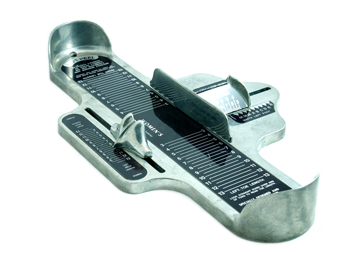
A good shoe should fit the shape of your foot. Poorly fitting shoes can cause all sorts of foot problems, including corns and bunions. With properly fitted shoes, your toes should be able to wiggle comfortably without hanging off the front of the shoe. Your heel should fit snugly and securely without feeling like it is slipping up and down. It is best to get your feet measured since one foot is usually larger than the other. Try shoes on both feet. Shoes should fit the larger foot. Pay attention to whether the shoes rub or pinch anywhere. Shoes should have at least ¼ inch between the longest toe and the end of the shoe for proper fit. For shoes with heels, make sure the toes lie together and are not cramped from wearing too high of a heel. If you plan to wear socks or stockings with shoes, try them on with those foot coverings. If you have questions about the proper fit of shoes, consult with a podiatrist who can help you.
It is important to find shoes that fit you properly in order to avoid a variety of different foot problems. For more information about treatment, contact Dr. Yeon A. Shim from Roselle Podiatry Group. Our doctor will treat your foot and ankle needs.
Proper Shoe Fitting
Shoes have many different functions. They cushion our body weight, protect our feet, and allow us to safely play sports. You should always make sure that the shoes you wear fit you properly in order to avoid injuries and deformities such as: bunions, corns, calluses, hammertoes, plantar fasciitis, stress fractures, and more. It is important to note that although a certain pair of shoes might be a great fit for someone else, that doesn’t mean they will be a great fit for you. This is why you should always try on shoes before buying them to make sure they are worth the investment. Typically, shoes need to be replaced ever six months to one year of regular use.
Tips for Proper Shoe Fitting
- Select a shoe that is shaped like your foot
- Don’t buy shoes that fit too tight, expecting them to stretch to fit
- Make sure there is enough space (3/8” to ½”) for your longest toe at the end of each shoe when you are standing up
- Walk in the shoes to make sure they fit and feel right
- Don’t select shoes by the size marked inside the shoe, but by how the shoe fits your foot
The shoes you buy should always feel as good as they look. Shoes that fit properly will last longer, feel better, and improve your way of life each day.
If you have any questions, please feel free to contact our office located in Roselle, NJ . We offer the newest diagnostic and treatment technologies for all your foot care needs.
Plantar Fasciitis May Develop From Several Reasons

When the plantar fascia becomes inflamed, it may be indicative of a foot condition referred to as plantar fasciitis. Research has shown plantar fasciitis affects approximately 10% of the population worldwide, and often causes severe heel pain. The plantar fascia, found on the sole of the foot, is a band of tissue that connects the heel to the toes. Excessive running or wearing shoes that do not fit correctly may cause the plantar fascia to become inflamed. Additionally, plantar fasciitis may develop from standing on hard surfaces for most of the day, or if the tissue becomes overstretched. Relief may be found when specific stretches are performed and shoes that are worn that have adequate cushioning. In severe cases, surgery may be necessary to permanently repair the plantar fascia. In patients who are overweight, it is suggested that eating healthy foods can help to reduce the effect body’s weight has on the soles of the feet. If you have heel pain, it is strongly suggested that you schedule an appointment with a podiatrist as quickly as possible who can diagnose and treat plantar fasciitis.
Plantar fasciitis can be very painful and inconvenient. If you are experiencing heel pain or symptoms of plantar fasciitis, contact Dr. Yeon A. Shim from Roselle Podiatry Group. Our doctor can provide the care you need to keep you pain-free and on your feet.
What Is Plantar Fasciitis?
Plantar fasciitis is the inflammation of the thick band of tissue that runs along the bottom of your foot, known as the plantar fascia, and causes mild to severe heel pain.
What Causes Plantar Fasciitis?
- Excessive running
- Non-supportive shoes
- Overpronation
- Repeated stretching and tearing of the plantar fascia
How Can It Be Treated?
- Conservative measures – anti-inflammatories, ice packs, stretching exercises, physical therapy, orthotic devices
- Shockwave therapy – sound waves are sent to the affected area to facilitate healing and are usually used for chronic cases of plantar fasciitis
- Surgery – usually only used as a last resort when all else fails. The plantar fascia can be surgically detached from the heel
While very treatable, plantar fasciitis is definitely not something that should be ignored. Especially in severe cases, speaking to your doctor right away is highly recommended to avoid complications and severe heel pain. Your podiatrist can work with you to provide the appropriate treatment options tailored to your condition.
If you have any questions please feel free to contact our office located in Roselle, NJ . We offer the newest diagnostic and treatment technologies for all your foot and ankle needs.
Arthritis Can Cause Pain in the Feet and Ankles
More...
Who Gets Cuboid Syndrome?
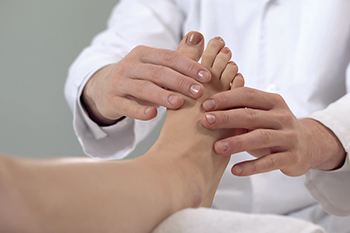
Cuboid syndrome can occur in an individual when the cuboid bone, located on the outer side of the foot, moves out of its place. This is typically caused by trauma or injury, and it may result in some kind of pain. Although cuboid syndrome is only 4% of all foot injuries, it can affect some individuals at a higher rate than others. For example, among professional ballet dancers, cuboid syndrome made up 17% of all foot and ankle injuries. Also, obese people and individuals who carry excessive body weight put more pressure on to their feet and are more likely to develop cuboid syndrome. If you are someone who wears shoes that do not fit properly or wears poorly constructed orthoses, then you are also at an increased risk of developing cuboid syndrome. Contact a podiatrist for advice and treatment regarding cuboid syndrome.
Cuboid syndrome, also known as cuboid subluxation, occurs when the joints and ligaments near the cuboid bone in the foot become torn. If you have cuboid syndrome, consult with Dr. Yeon A. Shim from Roselle Podiatry Group. Our doctor will assess your condition and provide you with quality foot and ankle treatment.
Cuboid syndrome is a common cause of lateral foot pain, which is pain on the outside of the foot. The condition may happen suddenly due to an ankle sprain, or it may develop slowly overtime from repetitive tension through the bone and surrounding structures.
Causes
The most common causes of cuboid syndrome include:
- Injury – The most common cause of this ailment is an ankle sprain.
- Repetitive Strain – Tension placed through the peroneus longus muscle from repetitive activities such as jumping and running may cause excessive traction on the bone causing it to sublux.
- Altered Foot Biomechanics – Most people suffering from cuboid subluxation have flat feet.
Symptoms
A common symptom of cuboid syndrome is pain along the outside of the foot which can be felt in the ankle and toes. This pain may create walking difficulties and may cause those with the condition to walk with a limp.
Diagnosis
Diagnosis of cuboid syndrome is often difficult, and it is often misdiagnosed. X-rays, MRIs and CT scans often fail to properly show the cuboid subluxation. Although there isn’t a specific test used to diagnose cuboid syndrome, your podiatrist will usually check if pain is felt while pressing firmly on the cuboid bone of your foot.
Treatment
Just as the range of causes varies widely, so do treatments. Some more common treatments are ice therapy, rest, exercise, taping, and orthotics.
If you have any questions, please feel free to contact our office located in Roselle, NJ . We offer the newest diagnostic and treatment technologies for all your foot care needs.
Foot Stretches Can Positively Affect the Overall Body
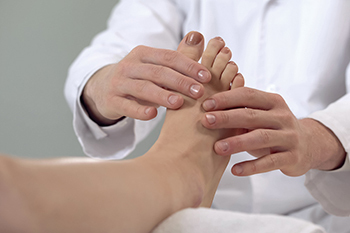
The feet carry the weight of the body, and it can help the overall body to keep them as healthy as possible. Stretching the feet is simple to do, and the benefits outweigh the time it takes to practice effective foot stretches. Specific stretches can improve range of motion, and may maintain strength and flexibility. An effective foot stretch is done sitting in a chair, with the feet flat on the floor. While keeping the toes on the ground, the heels are lifted until only the balls of the feet and toes can touch the ground. Also, the toes can become stronger when the foot is kept on the floor, while spreading the toes as wide as possible. Additionally, a good stretch for the toes involves crossing one leg over the other, and moving the toes with the hand back and forth. There are various stretches that can be done for different parts of the foot. If you would like more information about how to perform these, please consult a podiatrist.
Stretching the feet is a great way to prevent injuries. If you have any concerns with your feet consult with Dr. Yeon A. Shim from Roselle Podiatry Group. Our doctor will assess your condition and provide you with quality foot and ankle treatment.
Stretching the Feet
Being the backbone of the body, the feet carry your entire weight and can easily become overexerted, causing cramps and pain. As with any body part, stretching your feet can serve many benefits. From increasing flexibility to even providing some pain relief, be sure to give your feet a stretch from time to time. This is especially important for athletes or anyone performing aerobic exercises, but anyone experiencing foot pain or is on their feet constantly should also engage in this practice.
Great ways to stretch your feet:
- Crossing one leg over the others and carefully pull your toes back. Do 10-20 repetitions and repeat the process for each foot
- Face a wall with your arms out and hands flat against the wall. Step back with one foot and keep it flat on the floor while moving the other leg forward. Lean towards the wall until you feel a stretch. Hold for 30 seconds and perform 10 repetitions for each foot
- Be sure not to overextend or push your limbs too hard or you could risk pulling or straining your muscle
Individuals who tend to their feet by regular stretching every day should be able to minimize foot pain and prevent new problems from arising.
If you have any questions, please feel free to contact our office located in Roselle, NJ . We offer the newest diagnostic and treatment technologies for all your foot care needs.
Ledderhose Disease Is a Type of Plantar Fibromatosis

Patients who have hard or flattened nodules on the bottom of their feet may have a foot condition known as plantar fibromatosis. A specific type of this ailment is referred to as Ledderhose disease and it is a rare foot condition. Patients may notice it affects both feet and typically is painless in the beginning stages. Pain and discomfort may gradually occur while walking and medical attention is often sought from a podiatrist who can treat this condition. There are several reasons why this condition may occur, including genetic history, long-term alcohol use, chronic liver disease, and diabetes. Some of the symptoms that are associated with this condition may be joint pain in other areas of the body and some people may experience a tingling or numbing sensation. If you have small bumps on the bottom of your feet, it is strongly advised that you are under the care of a podiatrist who can effectively diagnose and treat Ledderhose disease.
Some foot conditions may require additional professional care. If you have any concerns, contact Dr. Yeon A. Shim of Roselle Podiatry Group. Our doctor can provide the care you need to keep you pain-free and on your feet.
Rare Foot Conditions
The majority of foot conditions are common and can be treated by a podiatrist. Standard diagnostic procedures are generally used to identify specific conditions and treatment can be rendered. A podiatrist also treats rare foot conditions which can be difficult to diagnose and may need extra attention and care.
There are many rare foot conditions that can affect children. Some of these can include:
- Freiberg’s disease
- Kohler’s disease
- Maffucci syndrome
Freiberg’s disease - This can be seen as a deterioration and flattening of a metatarsal bone that exists in the ball of the foot. It typically affects pre-teen and teenage girls, but can affect anyone at any age. Symptoms that can accompany this can be swelling, stiffness, and the patient may limp.
Kohler’s disease - This often targets the bone in the arch of the foot and affects younger boys. It can lead to an interruption of the blood supply which ultimately can lead to bone deterioration. The patient may limp or experience tenderness, swelling, and redness.
Maffucci syndrome - This affects the long bones in a child’s foot leading to the development of abnormal bone lesions. They are benign growths and typically develop in early childhood and the bones may be susceptible to breaking.
A podiatrist can properly diagnose and treat all types of rare foot conditions. If your child is affected by any of these symptoms or conditions, please don’t hesitate to call our office so the correct treatment method can begin.
If you have any questions please feel free to contact our office located in Roselle, NJ . We offer the newest diagnostic tools and technology to treat your foot and ankle needs.
Uncomfortable Plantar Warts
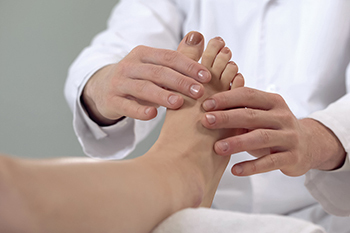
Plantar warts are found on the bottom of the feet, and can be very painful. The majority of warts grow outward, but plantar warts grow inward as a result of standing and walking for most of the day. The medical name for this type of wart is a verruca, and is connected with the human papillomavirus (HPV). The wart appears as a small, thickened area of skin on the bottom of the foot, and many times will have tiny black dots in the center. The virus can enter the body through small cracks in the skin of the feet, and generally lives in warm and moist environments. These can include public swimming pools, shower room floors, and locker rooms. It is advised that appropriate shoes, like flip flops or water shoes, are worn while in these areas. Plantar warts can be extremely uncomfortable, and many patients seek immediate relief. If you are afflicted with a plantar wart, please consult with a podiatrist who can discuss several effective treatment options with you.
Plantar warts can be very uncomfortable. If you need your feet checked, contact Dr. Yeon A. Shim from Roselle Podiatry Group. Our doctor will assist you with all of your foot and ankle needs.
About Plantar Warts
Plantar warts are the result of HPV, or human papillomavirus, getting into open wounds on the feet. They are mostly found on the heels or balls of the feet.
While plantar warts are generally harmless, those experiencing excessive pain or those suffering from diabetes or a compromised immune system require immediate medical care. Plantar warts are easily diagnosed, usually through scraping off a bit of rough skin or by getting a biopsy.
Symptoms
- Lesions on the bottom of your feet, usually rough and grainy
- Hard or thick callused spots
- Wart seeds, which are small clotted blood vessels that look like little black spots
- Pain, discomfort, or tenderness of your feet when walking or standing
Treatment
- Freezing
- Electric tool removal
- Laser Treatment
- Topical Creams (prescription only)
- Over-the-counter medications
To help prevent developing plantar warts, avoid walking barefoot over abrasive surfaces that can cause cuts or wounds for HPV to get into. Avoiding direct contact with other warts, as well as not picking or rubbing existing warts, can help prevent the further spread of plantar warts. However, if you think you have developed plantar warts, speak to your podiatrist. He or she can diagnose the warts on your feet and recommend the appropriate treatment options.
If you have any questions please feel free to contact our office located in Roselle, NJ . We offer the newest diagnostic and treatment technologies for all your foot and ankle needs.




